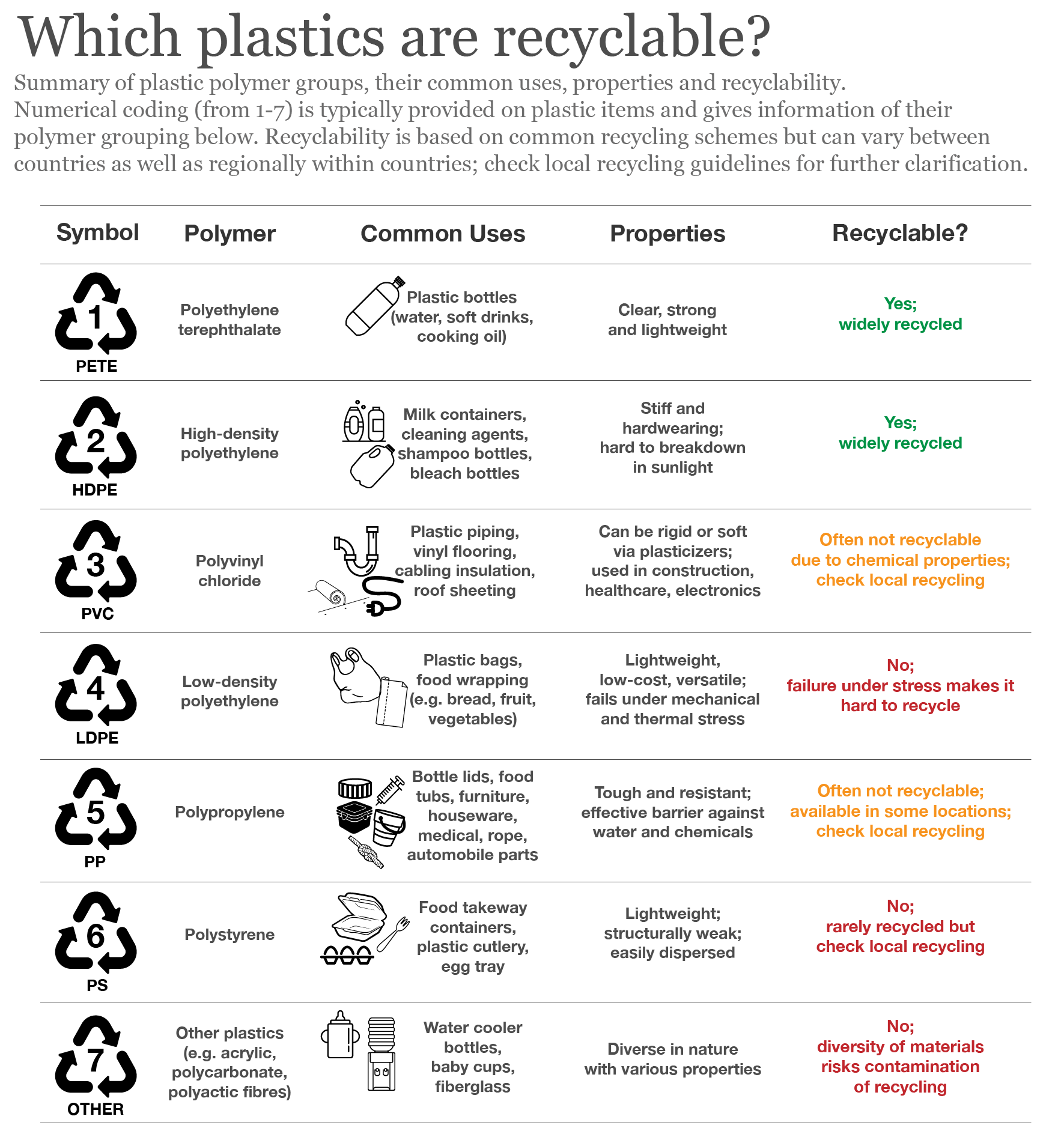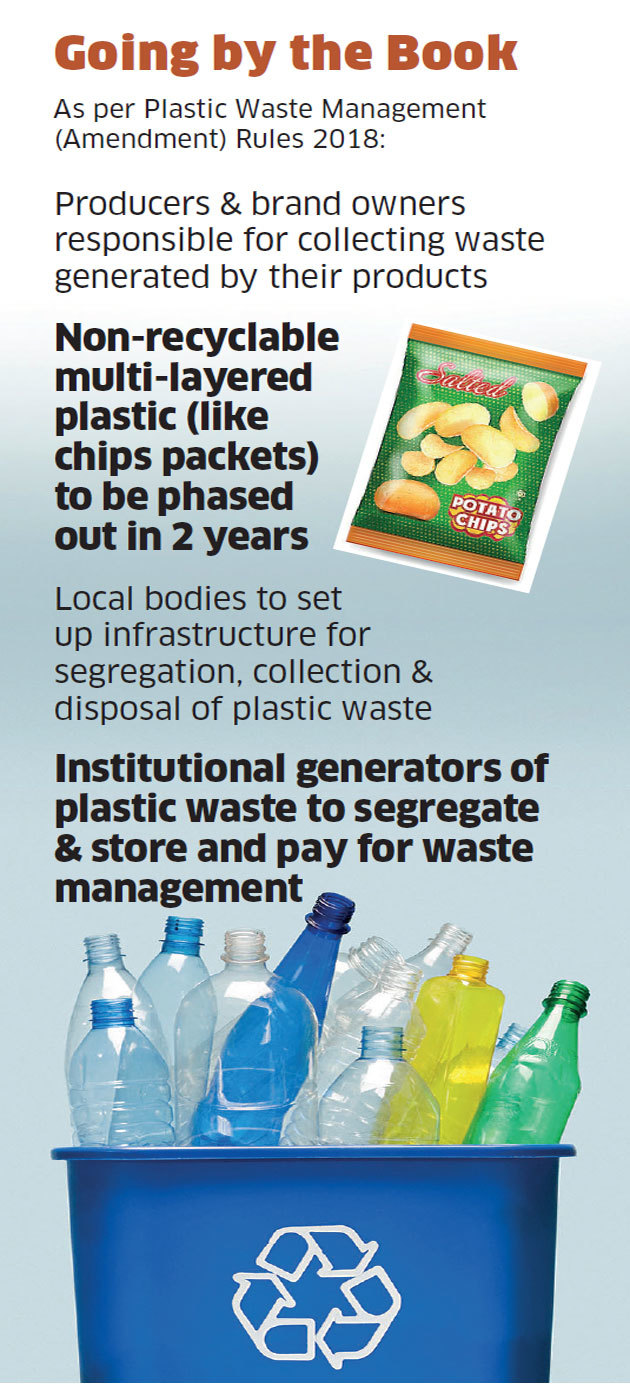Plastic Waste | 29 Oct 2019
Introduction
- Unlike other forms of wastes like paper, food peels, leaves etc, which are biodegradable (capable of being decomposed by bacteria or other living organisms) in nature, plastic waste because of its non-biodegradable nature persists into the environment, for hundreds (or even thousands) of years.
- Plastic pollution is caused by the accumulation of plastic waste in the environment. It can be categorized in primary plastics, such as cigarette butts and bottle caps, or secondary plastics, resulting from the degradation of the primary ones.
- A recent study conducted by Un-Plastic Collective has revealed that India generates 9.46 million tonnes of plastic waste annually, of which 40% remains uncollected and 43% is used for packaging, most of which are of single-use plastic.
Un-Plastic Collective
- Un-Plastic Collective (UPC) is a voluntary initiative launched by the UN-Environment Program-India, Confederation of Indian Industry and WWF-India.
- The Collective seeks to minimise externalities of plastics on the ecological and social health of our planet.
- As a part of UPC initiative companies set time-bound, public targets to:
- Eliminate unnecessary use of plastic.
- Reuse and circulate plastics through the circular economy.
- Replace plastic with sustainable alternative or recycled plastics.
- Turn commitments to meaningful and measurable action.
Types of Plastic Waste
- Microplastics are small plastic pieces of less than five millimeters in size.
- Microplastic includes microbeads (solid plastic particles of less than one millimeter in their largest dimension) that are used in cosmetics and personal care products, industrial scrubbers which are used for aggressive blast cleaning, microfibers used in textiles and virgin resin pellets used in plastic manufacturing processes.
- Apart from cosmetics and personal care products most of the microplastics result from the breakdown of larger pieces of plastic that were not recycled and break up due to exposure to the sun or physical wear.
- Single-use plastic is a disposable material that can be used only once before it is either thrown away or recycled, like plastic bags, water bottles, soda bottles, straws, plastic plates, cups, most food packaging and coffee stirrers are sources of single use plastic.
- India has announced its commitment to eliminate single-use plastic by 2022 at Confederation of Indian Industry’s Sustainability Summit in New Delhi.
Extent of Plastic Waste
- Plastic Waste as a Global Phenomenon:
- Over 8.3 billion tonnes of plastic has been produced since 1950, and about 60% of that has ended up in landfills or in the natural environment.
- Only 9% of all plastic waste ever produced has been recycled and about 12% has been incinerated, while the remaining 79% has accumulated in landfills, dumps or the natural environment.
- Plastic waste, whether in a river, an ocean, or on land can persist in the environment for centuries, hence by 2050, the amount of plastic in seas and oceans across the world will weigh more than the fish.
- Plastic Waste in India:
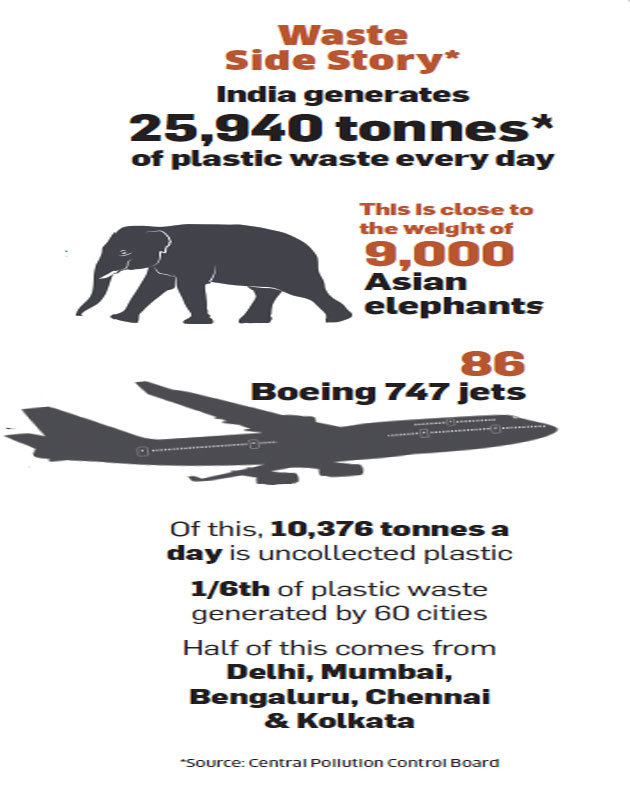
- According to the Central Pollution Control Board (CPCB), India generates close to 26,000 tonnes of plastic a day and over 10,000 tonnes a day of plastic waste remains uncollected.
- According to a Federation of Indian Chambers of Commerce and Industry (FICCI) study the plastic processing industry is estimated to grow to 22 million tonnes (MT) a year by 2020 from 13.4 MT in 2015 and nearly half of this is single-use plastic.
- India’s per capita plastic consumption of less than 11 kg, is nearly a tenth of the United States of America (109 kg).
Impact of Plastic Waste
- Economic Losses: Plastic waste along shoreline has a negative impact on tourism revenue (creates an aesthetic issue).
- For example, the Andaman and Nicobar Islands, are under the plastic threat and facing the aesthetic issue because of the international dumping of plastic waste at the island.
- Implications for Animals: Plastic wastes have profoundly affected animals in aquatic, marine, and terrestrial ecosystems.
- Plastic ingestion upsets or fills up the digestive systems of the animals thus contributing to their death due to intestinal blockage or starvation.
- Marine animals can also be trapped in plastic waste where they are exposed to predators or starve to death.
- The plastics may also contain toxic chemicals which can harm the animal’s vital organs or biological functions.
- Implications for Human Health: The chemicals leached from the plastics contain compounds, like polybrominated diphenyl ether (anti-androgen), bisphenol A (mimics the natural female hormone estrogen) and phthalates (also known as anti-androgens), impact human health leading to various hormonal and genetic disorders.
- These chemicals can interfere with the functioning of the endocrine system and thyroid hormones and can be very destructive to women of reproductive age and young children.
- Land Pollution: Plastics leach hazardous chemicals on land, resulting in the destruction and decline in quality of the earth’s land surfaces in term of use, landscape and ability to support life forms.
- Air Pollution: Plastic burning releases poisonous chemicals into the atmosphere impacting general well-being and causing respiratory disorders in living beings.
- Groundwater Pollution: Whenever plastics are dumped in landfills, the hazardous chemicals present in them seep underground when it rains. The leaching chemicals and toxic elements infiltrate into the aquifers and water table, indirectly affecting groundwater quality.
- Water Pollution: Many lakes and oceans have reported alarming cases of plastic debris floating on water surfaces, affecting a great number of aquatic creatures. It leads to dreadful consequences to marine creatures that swallow the toxic chemicals. In 2014, United Nation report estimated the annual impact of plastic pollution on oceans at US$ 13 billion.
- Interference with the Food Chain: Studies determine that the chemicals affect the biological and reproduction process resulting in reduced numbers of offspring thus disrupting the food chain.
- When the smaller animals (planktons, mollusks, worms, fishes, insects, and amphibians) are intoxicated by ingesting plastic, they are passed on to the larger animals disrupting the interrelated connections within the food chain.
- Poor Drainage: Drainage system clogged with plastic bags, films, and other plastic items, causes flooding.
- Impact on Habitats: Seafloor plastic waste sheets could act like a blanket, inhibiting gas exchange and leading to anoxia or hypoxia (low oxygen levels) in the aquatic system, which in turn can adversely affect the marine life.
- Invasive Species: Plastic waste can also be a mode of transport for species, potentially increasing the range of certain marine organisms or introducing species into an environment where they were previously absent. This, in turn, can cause subsequent changes in the ecosystem of the region.
Challenges
- Mismanaged Plastic Waste (plastic dumped openly): In the form of microplastics/microbeads when plastic enters the environment via inland waterways, wastewater outflows, and transport by wind or tides cannot all be filtered out once it enters the ocean.
- As plastics travel with ocean currents, an island of trash called the Great Pacific Garbage Patch has been created.
- Spurious Biodegradable Plastic: In the absence of robust testing and certification to verify claims made by producers, spurious biodegradable and compostable plastics are entering the marketplace.
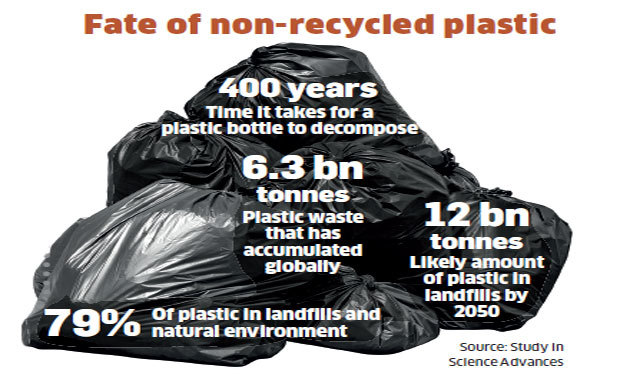
- Online or E-Commerce Companies: Apart from the plastic we consume through traditional retail, the popularity of online retail and food delivery apps, though restricted to big cities, is contributing to the rise in plastic waste.
- Microplastics: After entering into the aquatic environment, microplastics can travel vast distances floating in seawater, or sediment to the seabed. A recent study has revealed that microplastics in the atmosphere are trapped by the clouds and the falling snow.
- Microplastic particles are commonly white or opaque in color, which are commonly mistaken by many surface-feeding fishes as food (plankton) and can even move up the food chain to human consumers (from eating contaminated fish/seafood/shellfish).
- Marine Litter: Plastic pollution in freshwater and marine environments have been identified as a global problem and it is estimated that plastic pollution accounts for 60-80% of marine plastic waste.
- Terrestrial Plastic: 80% of plastic pollution originates from land-based sources with the remainder from ocean-based sources (fishing nets, fishing ropes).
- Improper Implementation and Monitoring: In spite of the notification of the Plastic Waste Management (PWM) Rules, 2016 and amendments made in 2018, local bodies (even the biggest municipal corporations) have failed to implement and monitor segregation of waste.
Solution: Plastic Waste Management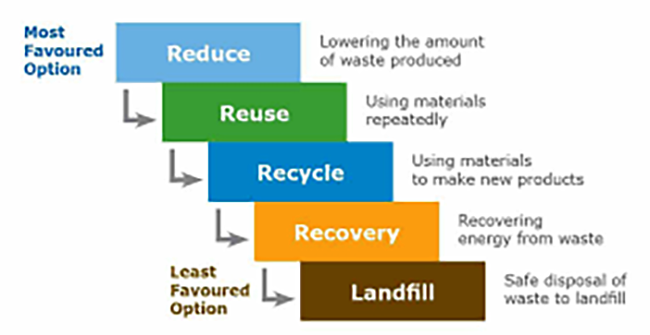
- Reduce: First step in reducing plastic waste is to minimize single use plastics by supporting a tax on plastic bags, restraint on manufacturing of plastics, and using alternatives of plastic or biodegradable plastic.
- For example Project REPLAN (stands for REducing PLastic in Nature) launched by Khadi and Village Industries Commission (KVIC) aims to reduce consumption of plastic bags by providing a more sustainable alternative.
- Reuse: Reusing plastics can reduce the demand for new plastics, hence it can act as the natural restrain on plastic manufacturing.
- Recycle: Plastic recycling is the process of recovering waste or scrap plastic and reprocessing it into useful products. It offers several benefits like:
- Economic benefits due to value addition
- Generates employment
- Reduces depletion of fossil fuel reserves.
- Reduces landfill problems
- Recycling of plastics requires less energy
- Recovery: It is the process of converting non-recyclable plastics into a range of useful forms of energy and chemicals for industry. Since plastics contain mainly carbon and hydrogen, with similar energy content to conventional fuels such as diesel, they can be used as a potential source of fuel.
Government and Global Interventions
- On World Environment Day, 2018 the world leaders vowed to “Beat Plastic Pollution” & eliminate its use completely.
- The Group of 20 (G20) environment ministers, agreed to adopt a new implementation framework for actions to tackle the issue of marine plastic waste on a global scale.
- Plastic Waste Management Rules, 2016 state that every local body has to be responsible for setting up infrastructure for segregation, collection, processing, and disposal of plastic waste.
- Plastic Waste Management (Amendment) Rules 2018 introduced the concept of Extended Producer Responsibility (EPR).
- A new national framework on plastic waste management is in the works, which will introduce third-party audits as part of the monitoring mechanism.
Extended Producer Responsibility (EPR)
- EPR is a policy approach under which producers are given a significant financial and physical responsibility (with respect to segregation and collection of waste at the source) for the treatment or disposal of post-consumer products.
- Assigning such responsibility could in principle provide incentives to prevent wastes at the source, promote product design for the environment and support the achievement of public recycling and materials management goals.
Way Forward
- Raising awareness amongst the public of the harm caused by plastic pollution through education and outreach programs to modify behavior.
- A movement against plastic waste would have to prioritise the reduction of single-use plastic such as multi-layer packaging, bread bags, food wrap, and protective packaging.
- Promote Alternatives, before the ban or levy comes into force, the availability of alternatives need to be assessed, hence the government may:
- Provide economic incentives to encourage the uptake of eco-friendly and fit-for-purpose alternatives that do not cause more harm.
- Support can include tax rebates, research and development funds, technology incubation, public-private partnerships and support to projects that recycle single-use items and turn waste into a resource that can be used again.
- Reduce or abolish taxes on the import of materials used to make alternatives.
- Provide incentives to the alternative industry by introducing tax rebates or other conditions to support its transition from plastic industry.
- Expanding the use of biodegradable plastics or even edible plastics made from various materials such as bagasse (the residue after extracting juice from sugarcane), corn starch, and grain flour.
- Use of microbeads in personal care products and cosmetics must be prohibited.
- The Swachh Bharat Mission should emerge as a platform for plastic waste management.
- Target the most problematic single-use plastics by conducting a baseline assessment to identify the most problematic single-use plastics, as well as the current causes, extent and impacts of their mismanagement.
- Consider the best actions to tackle the problem of plastic waste management (e.g. through regulatory, economic, awareness, voluntary actions) given the country’s socio-economic standing.
- Assess the potential social, economic and environmental impacts (positive and negative) of the preferred short-listed plastic waste management measures/actions, by considering how will the poor be affected, or what impact will the preferred course of action have on different sectors and industries.
- Identify and engage key stakeholder groups like retailers, consumers, industry representatives, local government, manufacturers, civil society, environmental groups, and tourism associations in order to ensure broad buy-in.
- Explaining the decision and any punitive measures that will follow, as a result of non compliance of plastic management rule.
- Use revenues collected from taxes or levies on single-use plastics to maximize the public good, thereby supporting environmental projects or boosting local recycling with the funds and creating jobs in the plastic recycling sector with seed funding.
- Enforce the plastic waste management measure effectively, by making sure that there is clear allocation of roles and responsibilities.
- Monitor and adjust the plastic waste management measure if necessary and update the public on progress.

